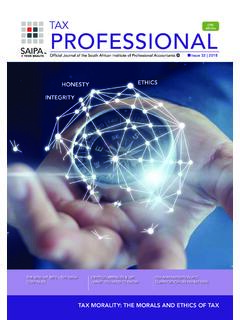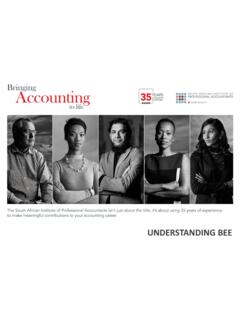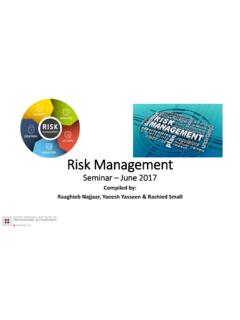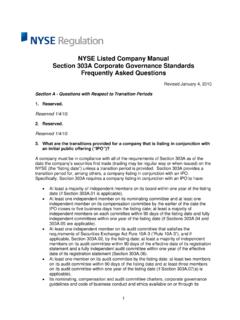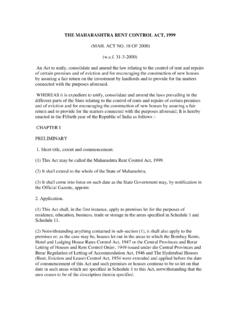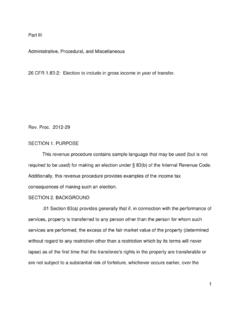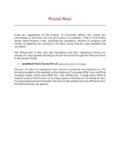Transcription of SECTION 29 DEFERRED TAX - SAIPA
1 SECTION 29 DEFERRED . TAX. SCOPE. SECTION 29 covers accounting for income tax It requires the recognition of current and future tax consequences of transactions/events recognised in financial statements ( ). OBJECTIVE. Understand why DEFERRED tax is necessary Understand what is meant by the tax base of an asset and the tax base of a liability Understand what is meant by temporary differences Measure DEFERRED tax balances using the balance sheet approach Understand how to account for DEFERRED tax when the revaluation model is elected for property, plant and equipment Understand the need for a tax rate reconciliation Prepare a tax rate reconciliation Present and disclose DEFERRED tax in the financial statement of a company INTRODUCTION. Income tax includes both domestic and foreign taxes as a result of taxable income ( ) Income: earlier of Accrual basis of Accounting Tax (SARS) receipt or accrual Differences accounti Expenses: ng Use own rules Use own rules when (IFRS) to (Income Tax incurred or determine how Act) to Reflect to recognise paid determine what substance income and tax is owed According over form expenses to legal form Accounting Taxable income profit THE TAX EXPENSE OF A COMPANY.
2 Tax expense is defined as the aggregate amount included in total comprehensive income and equity for the reporting period in respect of current and DEFERRED tax. The tax expense of an entity consists of the following components: Current Current tax year Under/over provision of tax in a prior year DEFERRED Arising on tax temporary differences DEFERRED TAX. Theoretically: tax expense per SOCI = 28% of profit before tax but it is not due to: Permanent Non-taxable items differences Non-deductible items Timing differences Temporary differences DEFERRED tax align taxable income with accounting profit in relation to temporary differences Tax rate recon explains what the permanent differences are that causes tax expense per SOCI 28% of profit before tax Page 4. DEFERRED TAX. DEFERRED tax balance =. future tax payable or receivable on expected future transactions that have already been recognised in the financial statements (as either assets or liabilities).
3 DEFERRED tax liability If assets (future inflows) > liabilities (future outflows) = expect future profit = pay tax in future DEFERRED tax asset If liabilities (future outflows) > assets (future inflows) =. expect future loss = pay less tax in future Page 4. DEFERRED TAX. Probable that the recovery of the carrying amount DEFERRED will make future tax tax liability payments larger Probable that the settlement of the carrying amount DEFERRED will make future tax tax asset payments smaller Page 4. DEFERRED TAX. Example 1: Liability giving rise to future tax consequences Waheeda (Pty) Limited has a profit before tax of R200. 000 in both 2015 and 2016. Income received in advance balance at end of 2015 was R50 000 and at end of 2016 was R0. The company tax rate remained constant at 28%. You are required to A Calculate the current tax of the company for both 2015 and year 2016. B Explain whether or not DEFERRED tax should be recognised in 2015.
4 C Explain whether or not we would recognise DEFERRED tax in year 2016. Page 5. DEFERRED TAX. Example 1: Liability giving rise to future tax consequences Solution A 2015 2016. Profit before tax (accounting profit) 200 000 200 000. Permanent differences - - Temporary differences Less income received in advance opening balance 0 (50 000). Add income received in advance closing balance 50 000 0. Taxable income 250 000 150 000. Tax rate 28% 28%. Current tax 70 000 42 000. Page 5. DEFERRED TAX. Example 1: Liability giving rise to future tax consequences Solution B At the end of 2015, the company had a liability of R50 000 for income received in advance. This amount would not have been included in accounting profit for the year but would be seen as taxable income so the company would have paid tax on it in 2015. In the following year, the R50 000 would be included in accounting profit but as it was already taxed in the previous year it would not be taxed again thus it would be added back in the taxable income calculation.
5 If this amount had been treated the same from the accounting perspective and the tax perspective then the company would have a tax expense of R56 000 for both years but as this is not the case the company has had to pay R70 000 in 2015 but only R42 000 in 2016. The liability balance of R50 000 at the end of 2015 has resulted in the company paying more tax in 2015 but less in 2016. Thus the company would need to record a DEFERRED tax asset at the end of the year as the consequences of the settlement of the liability will result in less tax having to be paid in the future. C At the end of 2016 the company no longer has a liability for the income received in advance thus there will be no DEFERRED tax. Page 5. TAX BASE. DEFERRED tax if: Tax base of asset =. Is the amount that will be deductible for tax purposes against any taxable economic benefits that will flow to a company when it recovers the carrying amount of the asset.
6 If those economic benefits will not be taxable, the tax base of the asset is equal to its carrying amount (eg investment in shares). Page 5. TAX BASE. Example 2: Tax base of prepaid expenses On 31 December 2015, Waheeda (Pty) Limited paid R20 000 cash for stationery. The stationery was only delivered in January 2016. You are required to A Determine the carrying amount of the prepaid expenses for 2015 and 2016. B Determine the tax base of the prepaid expenses for 2015 and 2016. C Determine if the prepaid expense asset gives rise to DEFERRED tax for 2015 and 2016. Page 6. TAX BASE. Solution A At the end of 2015 the company would recognise a prepaid expense asset of R20 000 as the stationery had been paid for but not delivered. By the end of 2016 the stationery had been delivered thus there would no longer be a prepaid expense asset. Carrying amount at end of 2015: R20 000. Carrying amount at end of 2016: R0.
7 B The prepaid expense is an asset for the company at the end of 2015. It relates to stationery of the company that will be used in the ordinary course of business to generate future income so it will give rise to future taxable income thus its tax base would be the amount that would be deductible in the future. For tax purposes, the prepaid expense is allowed as a deduction when it has been paid so it will reduce taxable income in 2015. Hence in 2016 and any years going forward there will be no further deductions thus at the end of 2015 and going forward the tax base of the prepaid asset would be R0. Tax base at end of 2015: R0. Tax base at end of 2016: R0. C DEFERRED tax arises if at the end of the year the carrying amount it different from the tax base. 2015: Carrying amount was R20 000 and the tax base was R0 thus there would be DEFERRED tax. 2016: Carrying amount was R0 and the tax base was R0 thus there would be no DEFERRED tax.
8 Page 6. TAX BASE. Example 3: Tax base of depreciable asset On 1 July 2013 Waheeda (Pty) Limited bought an machine for R300 000. Its accounting policy is to depreciate machine over 5 years using the straight line method. SARS allows a 25% pa wear and tear deduction each year not apportioned for time. The company's financial year end is 31 December. You are required to A Determine the carrying amount of the machine for 2015 and 2016. B Determine the tax base of the machine for 2015 and 2016. C Determine if the machine gives rise to DEFERRED tax for 2015 and 2016. Page 6. TAX BASE. Solution A The machine is an asset for the company. Carrying amount at end of 2015: (300 000 - 300 000/5* ) = R150 000. Carrying amount at end of 2016: (300 000 - 300 000/5* ) = R90 000. B The machine is an asset for the company at the end of 2015 and 2016. The machine will be used by the company in the ordinary course of business to generate future income so it will give rise to future taxable income thus its tax base would be the amount that would be deductible in the future.
9 For tax purposes, SARS allows a 25% pa wear and tear deduction not apportioned for time. Thus it will allow 25% in 2013, 25% in 2014, 25% in 2015 and 25% in 2016. At the end of 2015, the future deductions would be the 25% that SARS will allow in 2016. At the end of 2016, there are no further deductions that SARS will allow in the future. Tax base at end of 2015: (300 000 * ) = R75 000. Tax base at end of 2015: (300 000 * 0) = R0. C DEFERRED tax arises if at the end of the year the carrying amount it different from the tax base. 2015: Carrying amount was R150 000 and the tax base was R75 000 thus there would be DEFERRED tax. 2016: Carrying amount was R90 000 and the tax base was R0 thus there would be DEFERRED tax. Page 7. TAX BASE. Tax base of a liability =. The tax base of a liability is its carrying amount less any amount that will be deductible for tax purposes in respect of that liability in future periods.
10 In the case of revenue that is received in advance, the tax base of the resulting liability is its carrying amount less any amount of the revenue that will not be taxable in future periods. Page 7. TAX BASE. Example 4: Tax base of income received in advance On 31 December 2015, Waheeda (Pty) Limited received R16 000 cash in respect of the rent income for January 2016 from a tenant. You are required to A Determine the carrying amount of the income received in advance for 2015 and 2016. B Determine the tax base of the income received in advance for 2015 and 2016. C Determine if the income received in advance liability gives rise to DEFERRED tax for 2015. and 2016. Page 8. TAX BASE. Example 5: Tax base of income received in Solution A At the end of 2015 the company would recognise an income received in advance liability of advance R16 000 as the payment of the rent has been received in 2015 but the tenant will only occupy the space in the next year.

